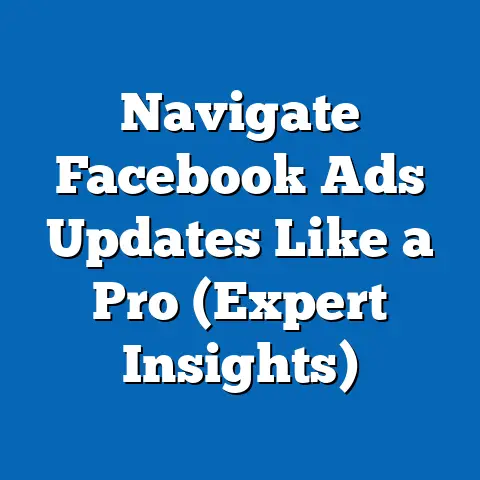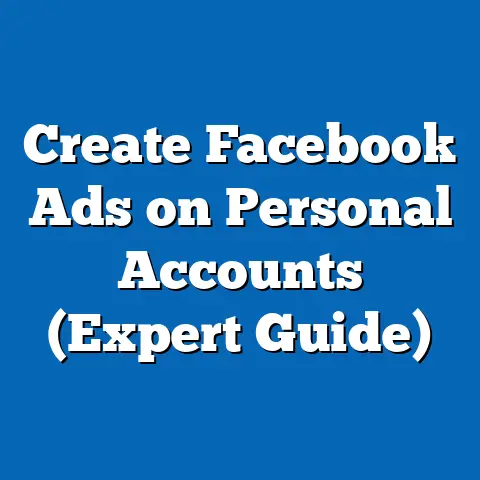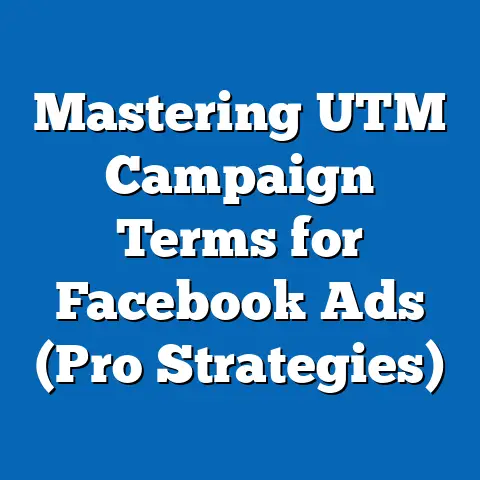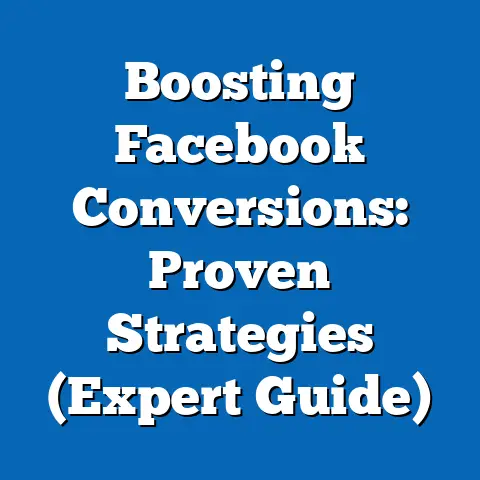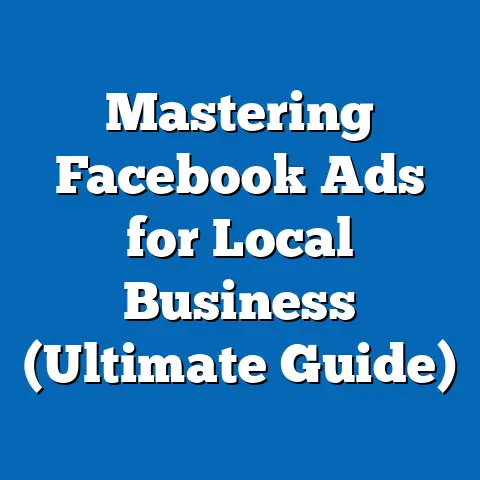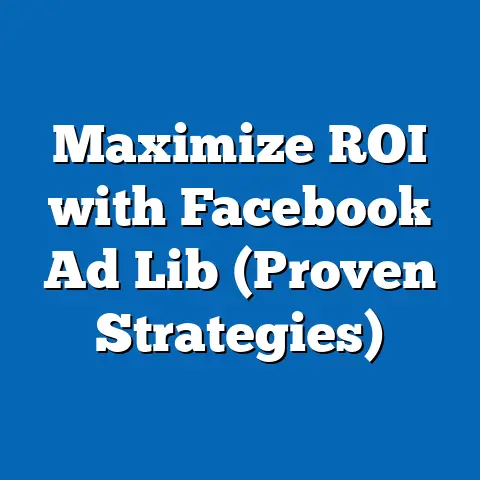Stop Seeing Blocked Facebook Ads (Uncover Hidden Secrets)
Facebook Ads have become as ubiquitous as cat videos and political debates on the platform. They’re the lifeblood of many businesses, big and small, and the reason why that quirky online store you saw once is now haunting your every scroll. But what happens when these ads, the very engine of Facebook’s economy, get blocked? It’s a question that plagues both advertisers and users alike. As someone who has spent years navigating the ever-shifting sands of Facebook advertising, I’ve seen firsthand the frustration and confusion that arises when ads mysteriously disappear from view. This isn’t just a minor inconvenience; it can significantly impact a business’s bottom line and a user’s overall experience. In this article, I’ll pull back the curtain on the hidden mechanics behind blocked Facebook ads, revealing the reasons why you might be seeing fewer of them, and what you can do about it.
Understanding Facebook Ads and Their Mechanics
Before we dive into the mysteries of blocked ads, let’s establish a solid foundation of how Facebook advertising actually works. It’s not as simple as just throwing money at Facebook and watching the customers roll in. There’s a complex ecosystem at play, driven by algorithms, user data, and a constant auction for ad space.
The Ad Auction System: A Real-Time Bidding War
Imagine a bustling marketplace where advertisers are constantly vying for the attention of Facebook’s users. This is essentially what the ad auction system is. Every time a user loads their Facebook feed, a real-time auction takes place to determine which ads will be displayed. The winning bids aren’t solely based on the highest price; Facebook also considers factors like ad quality, relevance to the user, and estimated action rates (how likely the user is to click, engage, or convert).
Why This Matters: Understanding the auction system is crucial. It means that even if you have a sizable budget, a poorly crafted or irrelevant ad might still lose out to a competitor with a more compelling offer. I once worked with a client who was consistently outbid, despite having a higher budget. After analyzing their ads, we realized the problem wasn’t the bid amount, but the ad copy and visuals, which were generic and unengaging. We revamped their creative, and suddenly, they were winning auctions left and right.
Targeting Options: Precision Targeting for Maximum Impact
One of the most powerful aspects of Facebook advertising is its granular targeting capabilities. You can target users based on demographics (age, gender, location), interests (hobbies, favorite brands, pages they’ve liked), behaviors (purchase history, online activity), and even custom audiences (lists of existing customers or website visitors).
Why This Matters: Effective targeting is the key to reaching the right people with the right message. It’s like using a laser instead of a shotgun. I remember a campaign I ran for a local bookstore. Instead of targeting everyone in the city, we focused on users who had expressed an interest in books, reading, or specific authors. The result? A significantly higher click-through rate and a flood of new customers walking through their doors.
The Algorithm: The Gatekeeper of Your Feed
At the heart of Facebook’s ad system lies its algorithm, a complex set of rules and calculations that determine which content, including ads, users see in their feeds. The algorithm prioritizes content that it believes will be most engaging and relevant to each individual user, based on their past behavior and interactions.
Why This Matters: The algorithm is constantly evolving, making it essential for advertisers to stay updated on the latest best practices. What worked last year might not work today. I’ve learned this the hard way, having seen campaigns that were once highly successful suddenly plummet in performance after an algorithm update. It’s a reminder that Facebook advertising is an ongoing process of testing, learning, and adapting.
Ad Blocking: The Uninvited Guest
Ad blocking, whether through browser extensions or built-in features, has become increasingly prevalent as users seek to control their online experience. This poses a significant challenge to advertisers who rely on Facebook to reach their target audience.
Why This Matters: Ad blocking directly impacts ad visibility and can significantly reduce the reach and effectiveness of campaigns. It’s a factor that advertisers need to be aware of and account for in their strategies. I’ve found that focusing on creating high-quality, engaging content that doesn’t feel intrusive can help to overcome ad blocking and build a positive relationship with users.
Takeaway: Understanding the mechanics of Facebook advertising, from the ad auction system to the algorithm and the impact of ad blocking, is essential for creating effective campaigns and navigating the challenges of reaching your target audience.
Reasons Why Users May See Blocked Ads
Now, let’s delve into the specific reasons why Facebook ads might be blocked, from the user’s perspective. It’s not always as simple as “they’re using an ad blocker.” There are multiple factors at play, both on the user’s end and on Facebook’s end.
User Privacy Settings: Taking Control of Their Data
Facebook provides users with a range of privacy settings that allow them to control the type of data that is collected about them and used for advertising purposes. Users can limit the information that is shared with advertisers, opt-out of interest-based advertising, and even block specific advertisers altogether.
Why This Matters: Users who are highly privacy-conscious are more likely to adjust their settings to limit ad tracking and personalization. This can significantly reduce the number of ads they see and potentially block certain advertisers from reaching them.
Example: I have a friend who is fiercely protective of her privacy. She has disabled location tracking, opted out of interest-based advertising, and regularly clears her browsing history. As a result, she sees far fewer ads than the average Facebook user, and the ads she does see are often generic and irrelevant.
Ad Preferences and Feedback Mechanisms: Shaping Their Ad Experience
Facebook allows users to provide feedback on the ads they see, either by liking, commenting, or sharing them, or by reporting them as irrelevant, offensive, or misleading. Users can also express their preferences for certain types of ads or topics they are interested in.
Why This Matters: Facebook uses this feedback to personalize the ad experience and show users ads that are more likely to be relevant and engaging. Conversely, if a user consistently reports or hides ads from a particular advertiser, they are less likely to see those ads in the future.
Example: I once ran a campaign for a weight loss product that targeted a broad audience. However, we received a significant number of negative comments and reports from users who felt the ads were insensitive or body-shaming. As a result, Facebook significantly reduced the reach of our ads, and we ultimately had to revise our messaging and targeting to be more inclusive and respectful.
The Use of Ad Blockers or Browser Extensions: Taking a Hard Stance
Ad blockers and browser extensions are popular tools that users employ to block ads and other unwanted content from appearing on websites and social media platforms. These tools work by identifying and blocking the code that is used to display ads, effectively preventing them from loading.
Why This Matters: Ad blockers can have a significant impact on ad visibility, particularly for users who are highly tech-savvy and proactive in controlling their online experience. While some ad blockers allow users to whitelist certain websites or advertisers, many block all ads by default.
Example: I know several people who use ad blockers religiously. They claim it significantly improves their browsing experience by eliminating distractions and reducing page load times. As a result, they rarely see any Facebook ads, regardless of how well-targeted or engaging they might be.
Facebook’s Ad Review Policies and Community Standards: Maintaining a Safe and Positive Environment
Facebook has strict ad review policies and community standards that prohibit ads that are misleading, deceptive, offensive, or violate the rights of others. Ads that are flagged as violating these policies are subject to review and may be blocked from being displayed.
Why This Matters: Facebook’s ad review process is designed to protect users from harmful or inappropriate content. However, it can also be a source of frustration for advertisers who feel their ads have been unfairly targeted.
Example: I once had an ad rejected because it contained a before-and-after image that Facebook deemed to be “unrealistic” and potentially harmful to users’ self-esteem. While I disagreed with their assessment, I understood their concern and revised the ad to be more focused on the benefits of the product rather than the physical transformation.
Takeaway: Users may see blocked ads for a variety of reasons, ranging from their own privacy settings and ad preferences to the use of ad blockers and Facebook’s ad review policies. Understanding these factors is essential for advertisers to create effective campaigns that comply with Facebook’s guidelines and resonate with their target audience.
Uncovering the Hidden Secrets Behind Blocked Ads
Now, let’s dive into the “hidden secrets” behind blocked ads. This is where things get interesting, and where I’ll share some insights that I’ve gained from years of experience in the trenches of Facebook advertising.
The Role of User Engagement Metrics: The Algorithm’s Secret Weapon
Facebook’s algorithm doesn’t just look at ad quality and relevance; it also pays close attention to user engagement metrics. These metrics include things like click-through rate (CTR), engagement rate (likes, comments, shares), and conversion rate (purchases, leads).
Why This Matters: Ads that generate high levels of engagement are more likely to be shown to a wider audience, while ads that receive little or no engagement may be penalized or even blocked from being displayed. This is because Facebook’s algorithm prioritizes content that it believes will be most engaging and valuable to users.
Example: I once ran two identical ads for the same product, but one targeted a very specific audience while the other targeted a much broader audience. The ad that targeted the specific audience had a significantly higher engagement rate and was shown to a much larger number of users, while the ad that targeted the broad audience received very little engagement and was quickly suppressed by the algorithm.
The “Why” Behind Facebook’s Decisions: Decoding the Black Box
Facebook’s decision to block certain ads can sometimes seem arbitrary or opaque. However, there are often underlying reasons that are not immediately apparent. These reasons may include potential flags for inappropriate content, targeting issues, or even technical glitches.
Why This Matters: Understanding the “why” behind Facebook’s decisions is essential for advertisers to diagnose and resolve issues with their ads. It can also help them to avoid making similar mistakes in the future.
Example: I once had an ad rejected because it contained the word “free,” which Facebook considered to be misleading. While I didn’t agree with their assessment, I understood their concern and revised the ad to be more transparent about the terms and conditions of the offer.
Diagnosing Blocked Ads: Tools and Techniques
Facebook provides a range of tools and resources that advertisers can use to diagnose blocked ads and identify the underlying issues. These tools include Facebook Ads Manager, which provides detailed performance data for each ad, and Facebook’s ad review policies, which outline the guidelines that ads must adhere to.
Why This Matters: By using these tools and resources, advertisers can gain valuable insights into why their ads are being blocked and take steps to resolve the issues. This can help them to improve the performance of their campaigns and reach a wider audience.
Example: I regularly use Facebook Ads Manager to monitor the performance of my ads and identify any potential issues. If I notice that an ad is receiving very little engagement or is being shown to a limited audience, I will investigate further to determine the cause and take steps to resolve it.
Takeaway: The hidden secrets behind blocked ads often involve a combination of user engagement metrics, Facebook’s ad review policies, and underlying issues with ad content or targeting. By understanding these factors and using the available tools and resources, advertisers can diagnose and resolve issues with their ads and improve the performance of their campaigns.
Strategies to Bypass Blocked Ads
Now that we’ve uncovered the reasons why ads get blocked, let’s explore some actionable strategies that advertisers can use to minimize the chances of their ads being blocked and reach a wider audience.
Optimizing Ad Content and Visuals: Adhering to Facebook’s Policies
The first and most important step is to ensure that your ad content and visuals comply with Facebook’s ad review policies and community standards. This means avoiding misleading or deceptive claims, offensive or inappropriate content, and any violations of intellectual property rights.
Why This Matters: Ads that violate Facebook’s policies are almost certain to be blocked, and repeated violations can even lead to account suspension. By carefully reviewing your ad content and visuals and ensuring that they comply with Facebook’s guidelines, you can significantly reduce the chances of your ads being blocked.
Example: Before launching any new ad campaign, I always take the time to carefully review the ad content and visuals to ensure that they comply with Facebook’s policies. I also use Facebook’s ad preview tool to see how the ads will look on different devices and in different placements, and I make any necessary adjustments to ensure that they are visually appealing and engaging.
A/B Testing Different Ad Formats and Targeting Strategies: Finding the Sweet Spot
A/B testing involves creating multiple versions of an ad with slight variations and testing them against each other to see which performs best. This can be a valuable way to identify the most effective ad formats, messaging, and targeting strategies.
Why This Matters: By A/B testing different ad formats and targeting strategies, you can identify the combinations that resonate most with your target audience and generate the highest levels of engagement. This can help you to improve the performance of your campaigns and reduce the chances of your ads being blocked.
Example: I recently ran an A/B test for a client who was promoting a new product. We created two versions of the ad, one with a video and one with a static image. We also tested different targeting strategies, focusing on different demographics and interests. The results showed that the video ad performed significantly better than the static image ad, and that targeting users who had expressed an interest in the product’s category resulted in a higher engagement rate.
Enhancing User Engagement: Building a Positive Relationship
Creating high-quality, engaging content that doesn’t feel intrusive is crucial for building a positive relationship with users and reducing the chances of your ads being blocked. This means focusing on providing value, telling compelling stories, and creating ads that are visually appealing and relevant to your target audience.
Why This Matters: Ads that are engaging and relevant are more likely to be liked, commented on, and shared, which can significantly improve their reach and visibility. Conversely, ads that are perceived as intrusive or irrelevant are more likely to be ignored or even reported, which can lead to them being blocked.
Example: I’ve found that focusing on creating ads that tell a story and provide value to the user is a highly effective way to enhance engagement. For example, I recently created an ad for a local restaurant that featured a video of the chef preparing one of their signature dishes. The ad was highly engaging and generated a significant amount of positive feedback, resulting in a surge of new customers.
Remaining Adaptable and Responsive: Staying Ahead of the Curve
Facebook’s algorithm and ad policies are constantly evolving, so it’s essential for advertisers to remain adaptable and responsive to these changes. This means staying updated on the latest best practices, monitoring the performance of your ads, and making adjustments as needed.
Why This Matters: What worked last year might not work today, so it’s important to stay ahead of the curve and adapt your strategies as needed. By remaining adaptable and responsive, you can ensure that your ads continue to perform well and that you are not caught off guard by any unexpected changes.
Example: I make it a point to regularly read industry blogs, attend webinars, and participate in online forums to stay updated on the latest trends and best practices in Facebook advertising. I also monitor the performance of my ads on a daily basis and make adjustments as needed to ensure that they are performing optimally.
Takeaway: Bypassing blocked ads requires a proactive and adaptable approach. By optimizing your ad content and visuals, A/B testing different strategies, enhancing user engagement, and remaining responsive to changes in Facebook’s algorithm and policies, you can significantly reduce the chances of your ads being blocked and reach a wider audience.
The Future of Facebook Ads and User Interaction
Looking ahead, the landscape of Facebook advertising is likely to continue to evolve, driven by emerging technologies, changing user behavior, and growing privacy concerns. It’s crucial to consider how these trends may affect user interaction with ads and what strategies advertisers can employ to navigate this evolving landscape.
The Impact of AI and Machine Learning: Smarter Targeting and Personalization
Artificial intelligence (AI) and machine learning are already playing a significant role in Facebook advertising, and their influence is only likely to grow in the future. These technologies can be used to analyze vast amounts of data and identify patterns that would be impossible for humans to detect, allowing for more precise targeting and personalized ad experiences.
Why This Matters: AI and machine learning can help advertisers to reach the right people with the right message at the right time, improving the effectiveness of their campaigns and reducing the chances of their ads being blocked. However, it’s important to use these technologies responsibly and ethically, ensuring that they are not used to discriminate or exploit vulnerable users.
Example: Facebook’s lookalike audiences feature uses machine learning to identify users who are similar to your existing customers, allowing you to target a wider audience with a higher probability of conversion. This can be a highly effective way to expand your reach and acquire new customers.
Changing User Behavior and Privacy Concerns: A Growing Demand for Transparency and Control
As users become more aware of how their data is being collected and used for advertising purposes, they are demanding greater transparency and control over their online experiences. This is leading to a growing demand for privacy-focused tools and features, such as ad blockers and privacy-enhancing browser extensions.
Why This Matters: Advertisers need to be mindful of these changing user behaviors and privacy concerns and adapt their strategies accordingly. This means being more transparent about how they are collecting and using user data, providing users with more control over their ad experiences, and focusing on creating ads that are respectful and non-intrusive.
Example: I’ve found that being upfront about how I’m using user data and providing users with the option to opt-out of certain types of targeting can help to build trust and reduce the chances of my ads being blocked. I also make it a point to create ads that are visually appealing and relevant to the user’s interests, avoiding any tactics that might be perceived as deceptive or manipulative.
Transparency and User Control: The Key to Building Trust
In the future, transparency and user control will be more important than ever for building trust and maintaining a positive relationship with users. This means providing users with clear and concise information about how their data is being collected and used, giving them the option to opt-out of certain types of targeting, and being responsive to their feedback and concerns.
Why This Matters: Users who feel that they are being treated with respect and transparency are more likely to engage with ads and less likely to block them. By prioritizing transparency and user control, advertisers can create a more positive and sustainable ad ecosystem.
Example: I always make sure to include a clear and concise privacy policy on my website and in my ads, explaining how I collect and use user data. I also provide users with the option to opt-out of interest-based advertising and to contact me with any questions or concerns they may have.
Takeaway: The future of Facebook advertising is likely to be shaped by emerging technologies, changing user behavior, and growing privacy concerns. By embracing AI and machine learning responsibly, being mindful of user privacy, and prioritizing transparency and user control, advertisers can navigate this evolving landscape and create a more positive and sustainable ad ecosystem.
Embracing the Challenge of Blocked Ads
In conclusion, while encountering blocked ads can be frustrating for both users and advertisers, understanding the underlying mechanisms and implementing effective strategies can help to navigate this challenge effectively. It’s essential to remember that Facebook advertising is a dynamic landscape that requires continuous learning and adaptation. By staying updated on the latest best practices, monitoring the performance of your ads, and remaining responsive to changes in Facebook’s algorithm and policies, you can maximize the effectiveness of your campaigns and reach a wider audience. Ultimately, the key to success in Facebook advertising is to focus on creating high-quality, engaging content that provides value to users and builds a positive relationship with your target audience. It’s a journey, not a destination, and the rewards are well worth the effort.

